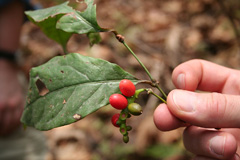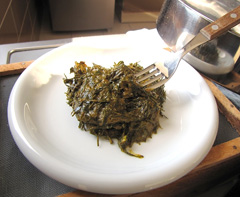 |
|
Marco Schmidt - wikimedia.org |
 |
| T.K. Naliaka - wikimedia.org |
Translate this page:
Summary
Eru or Gnetum africanum is an evergreen, perennial, shade-tolerant vine with woody stems of up to 12 m or more that twine from a tuberous rootstock. The narrowly oval leaves are papery-like and in groups of three and the branches are thickened at the nodes. Eru is mainly found in many parts in Africa where it is regarded as a very popular and highly valued vegetable. The leaves can be eaten raw or cooked. Fruit pulp, mature seeds, and tubers are edible as well. The leaves are laxative and used in the treatment of constipation, enlarged spleen, sore throat, piles, high blood pressure, nausea,warts, and boils. The stem can help to ease childbirth. It can also be used as a rope or made into traps and nooses for catching game due to its durability and flexibility.
Physical Characteristics

 Gnetum_africanum is an evergreen Climber growing to 12 m (39ft) by 0.4 m (1ft 4in) at a fast rate.
Gnetum_africanum is an evergreen Climber growing to 12 m (39ft) by 0.4 m (1ft 4in) at a fast rate.
See above for USDA hardiness. It is hardy to UK zone 10. The plant is not self-fertile.
Suitable for: light (sandy), medium (loamy) and heavy (clay) soils and prefers well-drained soil. Suitable pH: mildly acid, neutral and basic (mildly alkaline) soils. It can grow in semi-shade (light woodland) or no shade. It prefers moist soil.
UK Hardiness Map
US Hardiness Map
Synonyms
Thoa africana (Welw.) Doweld
Plant Habitats
Edible Uses
Leaves - raw or cooked[332 ]. Wherever it occurs in Africa, the leaf is valued as a tasty vegetable, usually eaten finely shredded for addition to soup or made up into condiments, or even taken raw[332 ]. To soften this rather tough vegetable, people often mix it with waterleaf (Talinum triangulare)[299 ]. Shredded leaves can be dried and preserved for later use[299 ]. The leaves have a very high nutritional value and constitute an important source of protein, essential amino acids and mineral elements[401 ]. Leafy stems remain fresh for at least a week after harvesting[299 ]. The dry matter content of the fresh leaves is much higher than for other dark or medium green leaf vegetables. This gives a feeling of firmness during preparation, hence certain consumers consider the leaves as a substitute for meat[299 ]. The leaves of this species are somewhat thinner and paler than the dark green leaves of the related Gnetum buchholzianum[299 ]. Fruit pulp[332 ]. Seed[332 ]. The mature seed is 15 - 15mm long, enclosed in a somewhat drupaceous orange-tinted envelope. The tubers are sometimes eaten - especially at times of scarcity[401 ]. Climbing members of this genus growing in Asia yield a potable sap[332 ]. This species should also be looked at in this respect[332 ].
References More on Edible Uses
Medicinal Uses
Plants For A Future can not take any responsibility for any adverse effects from the use of plants. Always seek advice from a professional before using a plant medicinally.
The leaf is used in the treatment of enlarged spleen, sore throat, piles, high blood pressure and as a cathartic[299 , 332 ]. It is eaten as a treatment against nausea and is considered antidotal against arrow-poison based on Parquetina nigrescens[299 , 332 ]. The leaves are chewed to mitigate the effects of drunkenness and they are taken as an enema against constipation[299 ]. Applied externally, the chopped-up leaf serves as a dressing on warts and boils to hasten maturation[332 , 401 ]. The stem is cut up into small pieces and infused to produce a tisane that is taken to ease childbirth and reduce the pain[332 ].
References More on Medicinal Uses
The Bookshop: Edible Plant Books
Our Latest books on Perennial Plants For Food Forests and Permaculture Gardens in paperback or digital formats.

Edible Tropical Plants
Food Forest Plants for Hotter Conditions: 250+ Plants For Tropical Food Forests & Permaculture Gardens.
More

Edible Temperate Plants
Plants for Your Food Forest: 500 Plants for Temperate Food Forests & Permaculture Gardens.
More

More Books
PFAF have eight books available in paperback and digital formats. Browse the shop for more information.
Shop Now
Other Uses
Other Uses: The stem is supple and strong. It is used as a rope[299 ], made into traps and nooses for catching game, and into straps for porterage[332 ].
Special Uses
References More on Other Uses
Cultivation details
A plant of humid, lowland tropical rainforests, being found at elevations from sea level to 1,200 metres[299 ]. It grows best in areas where the annual rainfall is around 3,000 mm[299 ]. Succeeds in dappled shade in the woodland. Plants growing in full sun produce thinner leaves which are not so well liked by consumers[299 ]. The plant tolerates a range of habitats and environmental conditions[338 ]. Cultivated plants need to be given some support, such as a tree, to grow into[299 ]. The plant forms two distinct types of stem. Growing up from the base, the stems produce only small, scale-like leaves, and they grow rapidly towards the light. Higher up, side shoots are formed with fully-developed leaves[299 ]. The plant continues to grow during the dry season and new shoots may develop where the stem has been cut or where side shoots have been removed[299 ]. New shoots are also formed from rhizomes that spread along the forest floor[299 ]. Current methods of harvest from wild stands are very destructive[299 ]. Controlled harvesting, in which only side shoots or parts of stems are collected, allows new shoots to develop where a stem has been cut or where side shoots have been removed[299 ]. Preliminary observations indicate that 3 - 4 harvests per year are possible, still allowing for substantial regrowth. More frequent harvesting will result in thin leaves that are considered inferior[299 ]. The first harvest may take place 6 - 9 months after planting. The total lifespan of the plant is estimated at over 10 years[299 ]. Preliminary observation indicates that in cultivation during the first harvest year the fresh leaf yield may reach 20 t/ha. This may double in subsequent years[299 ]. Under wild conditions, the plant grows and forms underground tubers or roots that store plant food reserves. These can remain alive for many years when the vegetation and the plant growth above ground are cleared and the soil surface is laid bare[401 ]. A dioecious species, both male and female forms need to be grown if fruit and seed are required. Female plants are often have stronger stems, and are more vigorous and productive than male plants[299 , 303 ].
References Carbon Farming Information and Carbon Sequestration Information
Temperature Converter
Type a value in the Celsius field to convert the value to Fahrenheit:
Fahrenheit:
The PFAF Bookshop
Plants For A Future have a number of books available in paperback and digital form. Book titles include Edible Plants, Edible Perennials, Edible Trees,Edible Shrubs, Woodland Gardening, and Temperate Food Forest Plants. Our new book is Food Forest Plants For Hotter Conditions (Tropical and Sub-Tropical).
Shop Now
Plant Propagation
Seed - difficult to germinate in nursery conditions, though the plants self-sow successfully in the wild[401 ]. It is assumed that seeds need pre-treatment, such as passing through the intestines of a bird, fruit bat, squirrel or other animal, before they germinate[299 ]. Seed is normally found only in the tree canopy[299 ]. Seed collection is thus far from easy, a further reason why the plant is hardly cultivated[299 ]. Methods of vegetative propagation using leafy stem cuttings have recently been developed. It is recommended that leaf blades of cuttings be trimmed in half[299 ]. Nursery beds under shade and made of well-decomposed sawdust or fine river sand can be used for propagation[299 ]. Ectomycorrhizae assist the roots in absorption of nutrients; the most common species reported is Scleroderma sinnamarense. After about 6 weeks the rooted cuttings are transferred to polythene sleeves, bamboo pots or other containers where they remain for a further 2 - 3 months. The soil mixture for these containers consists of 25% sand and some compost, supplemented with forest soil[299 ]. Field planting, preferably next to a young tree or shrub, takes place at the beginning of the rainy season[299 ].
Other Names
If available other names are mentioned here
Africa, including: Cameroon (Eru, okok, m’fumbua, or fumbua), Angola (KoKo), Nigeria (ukase or afang), Gabon (KoKo), Central African Republic (KoKo), Congo (KoKo), and the Democratic Republic of Congo (m’fumbua or fumbua). Eru has also been referred to as a form of ‘wild spinach’ in English. Afang, Ajakobale, Coco, Eru, Eruru, Fumbwa, Koko, Nkoko, Okazi, eru.
Native Range
AFRICA: Cameroon, Democratic Republic of the Congo, Congo, Gabon, Nigeria, Angola.
Weed Potential
Right plant wrong place. We are currently updating this section.
Please note that a plant may be invasive in one area but may not in your area so it’s worth checking.
Conservation Status
IUCN Red List of Threatened Plants Status : Status: Near Threatened

Growth: S = slow M = medium F = fast. Soil: L = light (sandy) M = medium H = heavy (clay). pH: A = acid N = neutral B = basic (alkaline). Shade: F = full shade S = semi-shade N = no shade. Moisture: D = dry M = Moist We = wet Wa = water.
Expert comment
Author
Welw.
Botanical References
1
Links / References
For a list of references used on this page please go here
A special thanks to Ken Fern for some of the information used on this page.
Readers comment
| Add a comment |
|
If you have important information about this plant that may help other users please add a comment or link below. Only comments or links that are felt to be directly relevant to a plant will be included. If you think a comment/link or information contained on this page is inaccurate or misleading we would welcome your feedback at [email protected]. If you have questions about a plant please use the Forum on this website as we do not have the resources to answer questions ourselves.
* Please note: the comments by website users are not necessarily those held by PFAF and may give misleading or inaccurate information.
To leave a comment please Register or login here All comments need to be approved so will not appear immediately.
|
Subject : Gnetum_africanum
|
|
|
|